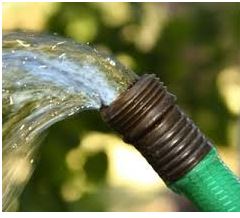CROSS CONNECTION CONTROL:
KEEPING YOUR DRINKING WATER SAFE
 Did you know that the garden hose at your home could jeopardize the safety of your drinking water? Understanding how cross connection control works will help you to protect your water supply.
Did you know that the garden hose at your home could jeopardize the safety of your drinking water? Understanding how cross connection control works will help you to protect your water supply.
A cross connection is a connection between two separate water systems that could cause contaminants to enter the water you drink. These connections are present in all homes and businesses.
By far the most common sources of cross connection contamination found in homes are garden hoses and irrigation systems. If you connect a hose to a sprayer to apply a pesticide or fertilizer, or submerge the end of a hose within a pool, hot tub or bucket of soapy water to wash your car, you could be introducing contaminants into your household water supply. Even if the hose or sprinkler head is not directly connected to a pesticide or fertilizer, it may have previously been submerged in standing water in your yard where chemicals or animal waste was present.
Here’s how it works: under normal pressure conditions water flows in one direction—from our network of water mains into your home. However, under certain conditions, the flow can be reversed, causing water and other substances—such as the pesticide, fertilizer and soapy water referenced above--to flow back into your home through your indoor plumbing. This can be caused by either backpressure, which is when pressure in your home exceeds pressure coming into your home from a public water main, or backsiphonage, which is when pressure coming into your home from a public water main decreases significantly due to a nearby water main break or a significant spike in water use for firefighting purposes.
So what can you do to prevent the threat of backflow contamination at your home? For a very inexpensive means of protection, install hose bib vacuum breakers on all outside faucets. These devices, which can be purchased at most home supply stores, are designed to allow water to flow in only one direction. Or, for an additional level of security, install an approved, testable backflow prevention assembly. Either SCWA or your plumber can assist you with choosing the right one.
These simple steps will protect your home’s drinking water as well as the public water supply, ensuring that your family and neighbors continue to enjoy safe drinking water. But if you have any questions, contact the experts on SCWA’s Cross Connection Control staff at (631) 563-0266 from 8 a.m. to 5 p.m. on weekdays and we’ll be happy to help. We can not only answer your questions about how to install and test backflow prevention devices, but also about New York State and Suffolk County laws governing backflow prevention.
SCWA maintains a program to ensure water from commercial facilities does not enter the public water supply. We require all commercial facilities where a potential hazard exists to install an approved backflow prevention device. While residential backflow prevention is not mandated by law, for the reasons stated above, we hope you’ll take the necessary steps to protect your water supply. And keep in mind that in addition to garden hoses and irrigation systems, household backflow can be caused by fire suppression systems, geothermal systems and chemically-treated boilers.